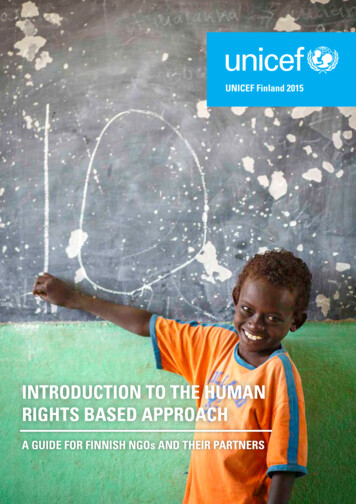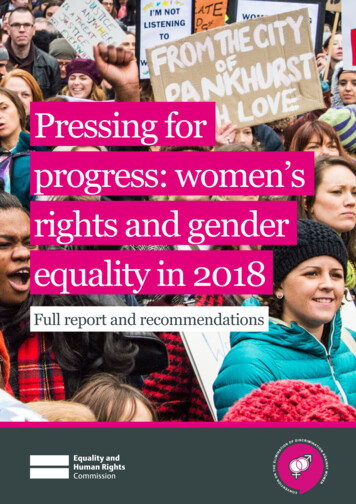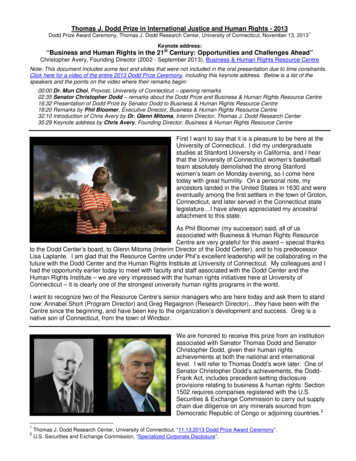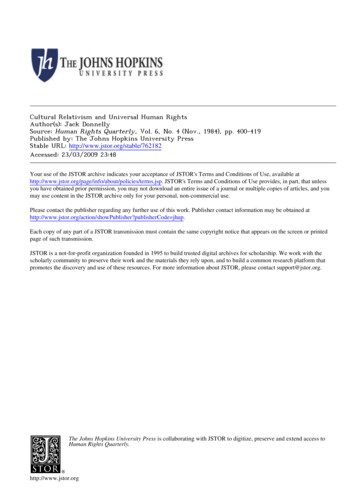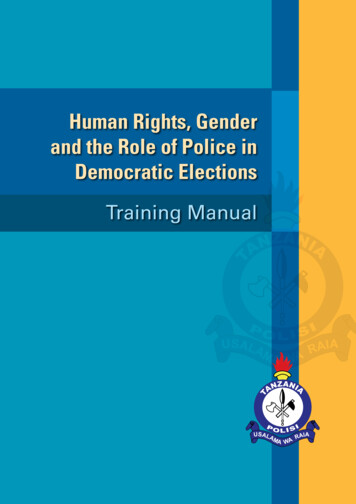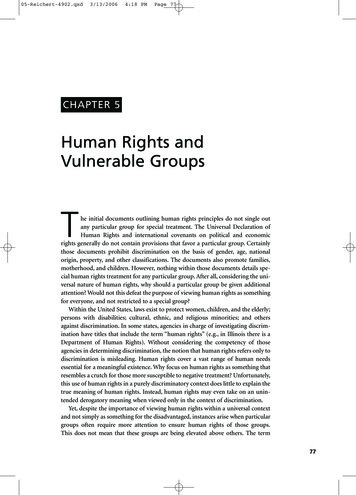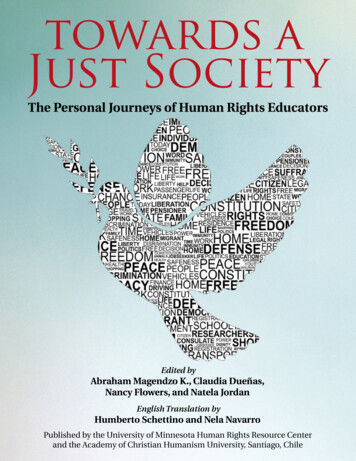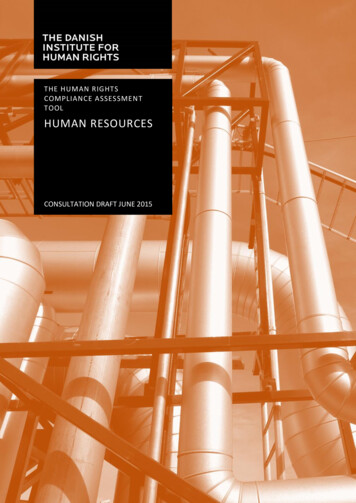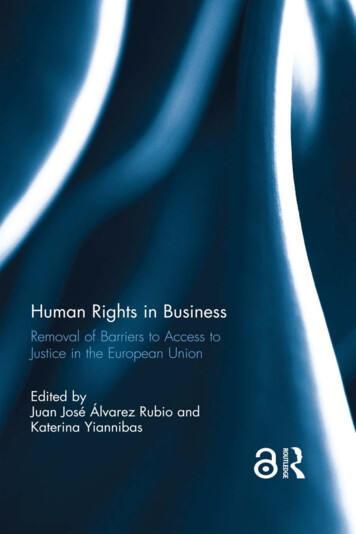
Transcription
Human Rights in BusinessThe capacity to abuse, or in general affect the enjoyment of human, labour andenvironmental rights has risen with the increased social and economic powerthat multinational companies wield in the global economy. At the same time,it appears that it is difficult to regulate the activities of multinational companiesin such a way that they conform to international human, labour and environmental rights standards. This has partially to do with the organization of companies into groups of separate legal persons, incorporated in different states, aswell as with the complexity of the corporate supply chain. Absent a businessand human rights treaty, a more coherent legal and policy approach is required.Faced with the challenge of how to effectively access the right to remedy inthe European Union for human rights abuses committed by EU companies innon-EU states, a diverse research consortium of academic and legal institutionswas formed. The consortium, coordinated by the Globernance Institute forDemocratic Governance, became the recipient of a 2013 Civil Justice ActionGrant from the European Commission Directorate General for Justice. A mandate was thus issued for research, training and dissemination so as to bringvisibility to the challenge posed and moreover, to provide some solutions forthe removal of barriers to judicial and non-judicial remedy for victims of businessrelated human rights abuses in non-EU states. The project commenced inSeptember 2014 and over the course of two years the consortium conductedresearch along four specific lines in parallel with various training sessions acrossEU Member States.The research conducted focused primarily on judicial remedies, both jurisdictional barriers and applicable law barriers; non-judicial remedies, both to companybased grievance. The results of this research endeavour make up the content ofthis report whose aim is to provide a scholarly foundation for policy proposalsby identifying specific challenges relevant to access to justice in the EuropeanUnion and to provide recommendations on how to remove legal and practicalbarriers so as to provide access to remedy for victims of business-related humanrights abuses in non-EU states.Juan José Álvarez Rubio is Professor of Private International Law at the University of the Basque Country (UPV/EHU), Spain and Secretary of the Globernance Institute for Democratic Governance.Katerina Yiannibas is an Assistant Professor of Public and Private InternationalLaw at Deusto University, Spain and a researcher at the Globernance Institutefor Democratic Governance.
HUMAN RIGHTS IN BUSINESSCO-BENEFICIARY INSTITUTIONSUNIVERSITY OF NAVARRAFRANK BOLD SOCIETYUNIVERSITY OF CASTILLA-LA MANCHAUNIVERSITY OF JAUME IROVIRA I VIRGILI UNIVERSITYPROFESSOR CEES VAN DAM CONSULTANCY LTD.LUDWIG BOLTZMANN INSTITUTE OF HUMAN RIGHTSTILBURG UNIVERSITYUTRECHT UNIVERSITYLEIDEN UNIVERSITYPUBLIC UNIVERSITY OF NAVARRACUATRECASAS, GONÇALVES PEREIRAUNIVERSITY OF RIJEKAGLOBERNANCE INSTITUTE FOR DEMOCRATIC GOVERNANCEThis project is co-funded bythe European UnionDisclaimer: This publication has been produced with the financial support ofthe Civil Justice Programme of the European Union. The contents of thispublication are the sole responsibility of the authors and can in no way be takento reflect the views of the European Commission.
Human Rights in BusinessRemoval of Barriers to Access toJustice in the European UnionEdited byJuan José Álvarez Rubioand Katerina Yiannibas
First published 2017by Routledge2 Park Square, Milton Park, Abingdon, Oxon OX14 4RNand by Routledge711 Third Avenue, New York, NY 10017Routledge is an imprint of the Taylor & Francis Group, an informabusiness 2017 selection and editorial matter, Juan José Álvarez Rubio andKaterina Yiannibas; individual chapters, the contributorsThe right of Juan José Álvarez Rubio and Katerina Yiannibas to beidentified as the author of the editorial material, and of the authorsfor their individual chapters, has been asserted in accordance withsections 77 and 78 of the Copyright, Designs and Patents Act 1988.The Open Access version of this book, available at www.tandfebooks.com,has been made available under a Creative Commons AttributionNon Commercial-No Derivatives 3.0 license.Trademark notice: Product or corporate names may be trademarks orregistered trademarks, and are used only for identification andexplanation without intent to infringe.British Library Cataloguing-in-Publication DataA catalogue record for this book is available from the British LibraryLibrary of Congress Cataloging-in-Publication DataNames: Rubio, Juan José Álvarez, editor. Yiannibas, Katerina, editor.Title: Human rights in business : removal of barriers to access to justice inthe European Union / edited by Juan José Álvarez Rubio andKaterina Yiannibas.Description: Abingdon, Oxon ; New York, NY : Routledge, 2017. Includes bibliographical references and index.Identifiers: LCCN 2016042618 ISBN 9781138284180 (hbk) ISBN 9781315269467 (ebk)Subjects: LCSH: Liability for human rights violations—European Unioncountries. Tort liability of corporation—European Union countries.Classification: LCC KJE1635 .H86 2017 DDC 344.2401—dc23LC record available at https://lccn.loc.gov/2016042618ISBN: 978-1-138-28418-0 (hbk)ISBN: 978-1-315-26946-7 (ebk)Typeset in Galliardby Apex CoVantage, LLC
ContentsNotes on contributorsAcknowledgmentsixxiIntroduction1KATE RI N A Y I ANNIBA S A ND L U CA S RO O RDA1Judicial remedies: The issue of jurisdictionD AN I E L AU G ENS T EIN A ND NICO L A JÄ GERS1.1 Overview 71.2 Impact of international human rights law on jurisdictionin private international law 81.2.1 Introduction 81.2.2 Human rights in private litigation 91.2.3 International human rights law and jurisdictionin private international law 111.3 Jurisdiction in private international law inEurope and the US 161.3.1 Introduction 161.3.2 The European approach: the Brussels I Regulation 171.3.2.1 Scope of application 171.3.2.2 Rules on jurisdiction 181.3.2.3 Policy debate regarding the reform of theBrussels I Regulation 191.3.3 The US approach to jurisdiction 221.3.3.1 Doctrines that may limit access to US courtsin transnational cases 231.3.3.2 The Alien Tort Statute: presumption againstextraterritoriality and personal jurisdiction 237
viContents1.3.3.3 Further doctrines that may limit access to US courtsin transnational cases 251.3.3.4 Litigating torts in state courts and/or under statelaw 261.3.4 Comparing the EU and US approach to jurisdictionin private international law 271.4 Residual jurisdiction in Europe 271.4.1 Introduction 271.4.2 Forum necessitatis 281.4.3 Joining of defendants 311.4.4 Pursuing civil remedies through criminal jurisdiction 341.5 Conclusions and recommendations 362Judicial remedies: The issue of applicable law38L . F. H . ( L I ES BET H) ENNEKING2.1 Introduction 382.2 Legal context 382.2.1 Foreign direct liability and beyond 392.2.2 Private international law and extraterritoriality 432.2.3 Discussion 472.3 Applicable law 482.3.1 Rome II Regulation: general rule 492.3.2 Rome II Regulation: special rule on environmentaldamage 522.3.3 Rome II Regulation: relevant exceptions 552.3.3.1 Overriding mandatory provisions 552.3.3.2 Rules of safety and conduct 582.3.3.3 Public policy 602.3.4 Discussion 612.4 Procedural rules and practical circumstances 652.4.1 General observations 662.4.2 The financing of claims, collective redress andaccess to evidence 672.4.3 Role of Article 6 ECHR 692.4.4 Discussion 712.5 Conclusions and recommendations 743Non-judicial remedies: Company-based grievancemechanisms and international arbitrationKATH ARI N A HÄ U S L ER, KA RIN L U KA S A ND JULIA PLANITZ ERCAS E S TU D IES : JU L IA P L A NIT ZER, PA BL O PAISÁN R UIZ ,KATE RI N A YIA NNIBA S78
Contentsvii3.1 Introduction 783.1.1 Context of research 783.1.2 Research interest 813.1.3 Definitions and methodology 833.2 Case studies on company-based grievance mechanisms 863.2.1 Siemens AG (case study by Julia Planitzer) 863.2.1.1 General description of the company and itsgrievance mechanism 863.2.1.2 Evaluation of the mechanism along the establishedcriteria 923.2.1.3 Concluding remarks 953.2.2 Statoil (case study by Pablo Paisán Ruiz) 963.2.2.1 General description of the company and itsgrievance mechanism 963.2.2.2 Evaluation of the mechanism along the establishedcriteria 1023.2.2.3 Concluding remarks 1033.3 Case study on the potential of the arbitrationmechanism: Permanent Court of Arbitration(case study by Katerina Yiannibas) 1053.3.1 General description and functioning ofthe Permanent Court of Arbitration 1053.3.2 Evaluation of the mechanism along the establishedcriteria 1083.3.2.1 Legitimacy 1083.3.2.2 Accessibility and predictability 1103.3.2.3 Transparency and a source of continuouslearning 1113.3.2.4 Rights-compatibility 1123.3.3 Concluding remarks 1133.4 Conclusions and recommendations 113Annex: list of interview partners 1184Corporate responsibility to respect human rightsvis-à-vis legal duty of careCEES VAN D AM A ND FIL IP GREGO R WIT H CONTR IBUTIONF RO M S AN D RINE BRA CHO T T E A ND PA IGE MOR R OW4.1 Introduction 1194.2 Legal context 1214.2.1 Implementing the UN Guiding Principles 1214.2.2 Following the general legal trend 122119
viiiContents4.3 Scenarios 1254.3.1 Scenario I: access to evidence on control 1254.3.1.1 Background 1254.3.1.2 Description of Scenario I 1274.3.1.3 Feasibility 1274.3.1.4 Effectiveness 1284.3.2 Scenario II: rebuttable presumption of control 1284.3.2.1 Background 1284.3.2.2 Description of Scenario II 1284.3.2.3 Feasibility 1294.3.2.4 Effectiveness 1304.3.3 Scenario III: statutory duty for a companyto conduct human rights due diligence 1304.3.3.1 Background 1304.3.3.2 Description of Scenario III 1304.3.3.3 Feasibility 137Conclusion139J U AN J O S É Á LVA REZ RU BIO A ND KAT ERIN A YIANNIBASIndex144
Notes on contributorsDaniel Augenstein works as Associate Professor in the Department of Europeanand International Public Law at Tilburg Law School.Sandrine Brachotte is a Legal Consultant at Frank Bold Society.L.F.H. (Liesbeth) Enneking is an Assistant Professor at UCALL, the UtrechtCentre for Accountability and Liability Law of Utrecht University.Filip Gregor is Head of the Responsible Companies Section at Frank BoldSociety.Katharina Häusler worked as a researcher at the Ludwig Boltzmann Instituteof Human Rights until August 2016.Nicola Jägers holds the Chair International Human Rights Law at the LawSchool of Tilburg University in the Netherlands.Karin Lukas is a senior researcher at the Ludwig Boltzmann Institute of HumanRights and member of the European Committee of Social Rights (Councilof Europe).Paige Morrow is Head of Brussels operations at Frank Bold Society.Pablo Paisán Ruiz is a lawyer at Cuatrecasas, Gonçalves Pereira.Julia Planitzer is a senior researcher at Ludwig Boltzmann Institute of HumanRights.Lucas Roorda is a researcher at the Institute of International, Social and Economic Public Law at Utrecht University and member of the Utrecht Centrefor Accountability and Liability Law (UCALL).Juan José Álvarez Rubio is Professor of Private International Law at the Universityof the Basque Country (UPV/EHU), Spain and Secretary of the GlobernanceInstitute for Democratic Governance.Cees van Dam is Professor of International Business and Human Rights at theRotterdam School of Management (Erasmus University), teaches as a VisitingProfessor English and Comparative Tort Law at King’s College London, and
xNotes on contributorsis Honorary Professor of European Private Law at Utrecht University and ispart time Professor of European Tort Law at Maastricht University.Katerina Yiannibas is an Assistant Professor of Public and Private InternationalLaw at Deusto University and a researcher at the Globernance Institute forDemocratic Governance.
AcknowledgmentsThe research leading to this report has received funding from the EuropeanCommission’s Civil Justice Programme under the Action Grant JUST/2013/JCIV/AG/4661. The research consortium, led by the Globernance Institutefor Democratic Governance, is composed of a diverse set of legal scholars andpractitioners from various EU Member States: Juan José Álvarez Rubio (Globernance Institute for Democratic Governance), Daniel Augenstein (Tilburg University), María Victoria Camarero Suárez (University of Jaume I), AntonioCardesa-Salzmann (Rovira i Virgili University), A.G. Castermans (Leiden University), Liesbeth F.H. Enneking (Utrecht University), María Font Mas (Rovirai Virgili University), Filip Gregor (Frank Bold Society), Katharina Häusler(Ludwig Boltzmann Institute of Human Rights), José Luis Iriarte Ángel (PublicUniversity of Navarra), Nicola Jägers (Tilburg University), Ivana Kunda (University of Rijeka), Eduard Kunstek (University of Rijeka), Karin Lukas (LudwigBoltzmann Institute of Human Rights), Daniel Iglesias Márquez (Rovira i VirgiliUniversity), Jordi Jaria Manzano (Rovira i Virgili University), José AntonioMoreno Molina (University of Castilla-La Mancha), Paige Morrow (Frank BoldSociety), Alberto Muñoz Fernández (University of Navarra), Pablo Paisán Ruiz(Cuatrecasas Gonçalves Pereira SLP), Lorena Sales Pallarés (University of CastillaLa Mancha), Augustín Viguri Perea (University of Jaume I), Antoni Pigrau Solé(Rovira i Virgili University), Julia Planitzer (Ludwig Boltzmann Institute ofHuman Rights), Lucas Roorda (Utrecht University), María Álvarez Torné(University of Barcelona), Cees van Dam (Professor Cees van Dam ConsultancyLtd.), Katerina Yiannibas (Globernance Institute for Democratic Governance),and Francisco Javier Zamora Cabot (University of Jaume I). Particular recognition and appreciation is given to Nicolás Zambrana Tevár for bringing togetherthe consortium.The authors would like to thank the following individuals for their valuableinputs: Carmen Agoués Mendizabal (Spain), José Miguel Ayerza (Spain), DenisBensaude (France), Robin Bouvier (France), Stéphane Brabant (France), DavidChivers, QC (UK), Sandra Cossart (France), Brooks W. Daly (Netherlands),Ingrid Gubbay (UK), Patrick Harty (UK), Mariëtte van Huijstee (Netherlands),Charlotte Jacobs (Netherlands), Lise Johnson (US), Rasmus Kløcker Larsen(Sweden), Niki Koumadoraki (Austria), Nerea Magallón Elósegui (Spain), Yvon
xiiAcknowledgmentsMartinet (France), María Chiara Marullo (Spain), Robert McCorquodale (UK),Sarah McGrath (US), Vanesa Menendez (Spain), Krishnendu Mukherjee (UK),Telmo Olascoaga (Spain), Marta Requejo Isidro (Luxembourg), Cedric Ryngaert(Netherlands), Urs Rybi (Switzerland), Channa Samkalden (Netherlands), AnneScheltema Beduin (Netherlands), John Sherman (US), Christopher Schuller(Germany), Gwynne Skinner (US). The authors would also like to thank theAustrian Federal Ministry of Labour, Social Affairs and Consumer Protection(BMASK), the Business Association of Gipuzkoa (Adegi), the Chamber ofLabour Vienna, the European Capital of Culture San Sebastian 2016 Foundation, the European Coalition for Corporate Justice (ECCJ), the EuropeanNetwork of National Human Rights Institutions (ENNHRI), the Ministry ofForeign Affairs of the Netherlands, the MVO Platform, the San Telmo Museum,and the Centre for Research on Multinational Corporations (SOMO) for theircontributions and support.
IntroductionKaterina Yiannibas and Lucas RoordaOn 24 April 2013, a factory collapsed in the Savar subdistrict of Bangladesh,killing more than 1,100 people and injuring more than 3,000. Three years later,the name of that factory is synonymous with irresponsible business practices:Rana Plaza. Following the disaster, many reports came out about the workingconditions in the factory, overcrowding and the substandard construction ofthe factory itself. The criticism was not just confined to the Rana Plaza factory,but was directed at the whole of the Bangladeshi clothing industry and its buyers, many of which are company brands based in the European Union (EU).Garments from Rana Plaza were allegedly made for Spanish clothing giant Zara,Italian fashion house Benetton, and Irish retailer Primark.However, it is not just European clothing companies that are accused ofirresponsible behaviour.1 Other examples include European resource extractioncompanies whose activities were connected to environmental damage in localcommunities, or that have worked together with authoritarian regimes to suppress protests against those environmental impacts. Yet other European companies have been accused of maintaining unsafe and unhealthy workingenvironments in production facilities operated by their subsidiaries, or violatingother labour rights.2The capacity to abuse, or in general affect the enjoyment of human, labourand environmental rights, has risen with the increased social and economicpower that multinational companies (MNCs) wield in the global economy. Atthe same time, it appears that it is difficult to regulate the activities of MNCs1 The term ‘company’ is used here to denominate non-governmental, for-profit entities withlegal personality that conduct commercial transactions. The word ‘companies’ appears to bemore common in the European context, whereas American and Canadian authors tend torefer more to these entities as ‘corporations’. As this report concerns the European Union,the authors have opted for the former, noting that for the purposes of this work the twoterms can be regarded as synonyms.2 See for a (non-exhaustive) list of judicial complaints on these issues against European companies, the website of the Business & Human Rights Resource Centre, t-filed/europe-central-asia.
2Katerina Yiannibas and Lucas Roordain such a way that they conform to international human, labour and environmental rights standards. This has partially to do with the organization of companies into groups of separate legal persons, incorporated in different states, aswell as with the complexity of the corporate supply chain.3 Absent a businessand human rights treaty, a more coherent legal and policy approach is required.The debate regarding this policy approach is currently governed by the UnitedNations Guiding Principles on Business and Human Rights (‘UN GuidingPrinciples’ or UNGPs).4 Unanimously endorsed by the UN Human RightsCouncil as an operationalization of the 2008 ‘Protect, Respect and Remedy’Framework, the UN Guiding Principles have sought to clarify the respectiveroles and responsibilities of states, businesses and those affected by businessrelated human rights abuses. The 2008 Framework and the Guiding Principlesdo so through a three-pillar structure: the state duty to protect against thirdparty human rights abuses, the corporate responsibility to respect human rightsof those affected by their operations, and the right of victims to an effectiveremedy if human rights abuses do occur.The UN Guiding Principles are but the start of the debate, laying downissues to be addressed and providing the terminology with which the debatecan be conducted. The actual legal and policy developments have to come fromstates themselves, in pursuance of their obligations and responsibilities underhuman rights law. Nowhere is this emphasized more than under the First Pillarand General Principle 1, putting on states the obligation to ‘protect againsthuman rights abuse within their territory and/or jurisdiction by third parties,including business enterprises.’ States are thus still the primary actors in securingan optimum respect for human rights in business activities.The state duty to protect is complemented by the right of victims to aneffective remedy. No matter how clear expectations are for companies to conducttheir activities responsibly, no matter how well developed the legal regimegoverning those activities is, there will always be the need for a remedy forvictims, when business operations adversely affect their human rights. Nevertheless, in the first five years after the adoption of the UN Guiding Principles, thethird pillar and the right to remedy have received scarce attention. While someof the national action plans that have currently been published do acknowledgethe relevance of the Third Pillar and the right to remedy, the attention paid tothe Third Pillar in relation to the first two pillars is limited and very few concreterecommendations can yet be found.53 R. Mares, Limits of Supply Chain Responsibility: A Critical Analysis of Corporate Responsibility Instruments (2010) Nordic Journal of International Law, 79, No 2.4 UN HRC, ‘Guiding Principles on Business and Human Rights: Implementing the UnitedNations’ “Protect, Respect and Remedy” Framework’, A/HRC/17/31, 21 March 2011.5 See for a general overview of the National Action Plans drafted thus far, UN OCHCR,State National Action Plans, available at onalActionPlans.aspx. Note that of those NAPs already written and published,all but Colombia and Norway are EU Member States, the latter of course having strongties with the EU.
Introduction 3The right to remedy comprises a large spectrum of interrelated mechanisms,some explicitly addressed in the UN Guiding Principles, some more implicitlypresent. At the core are state-based, judicial remedies as recognized in GeneralPrinciple 26, but non-judicial and non-state based mechanisms also play anadditional part. Regarding judicial mechanisms, states have an obligation toremove ‘legal, practical and other relevant barriers’ to effective remedies. Suchbarriers may include lack of jurisdiction by the courts of a particular state, questions of which law is to be applied, absence of duties of care on the parentcompany, availability of legal funding and representation, and many others.Overcoming these barriers requires of states that they develop a clear view ofwhich barriers are problematic in their own legal systems, and develop coherentpolicies as to how they will address those barriers.The relevance of this question does not emanate solely from the UN GuidingPrinciples. Victims of business-related human rights abuses have increasingly beenseeking remedies in the domestic legal systems of the parent companies relatedto a particular rights abuse. This movement has for a time mostly been presentin the US, where the Alien Tort Statute (ATS)6 has made it possible for plaintiffscoming from third states to file tort claims over violations of international humanrights law by US as well as foreign companies in US federal courts. However,the US Supreme Court’s recent decisions in Kiobel v Royal Dutch Shell (133S.Ct. 1659 (2013)) regarding the extraterritorial reach of the ATS, and DaimlerAG v Bauman (134 S. Ct. 746 (2014)) on the limits of personal jurisdiction inUS courts, have made US courts less attractive for such claims. Already, moreand more litigants find their way into European courts concerning human rightsabuses connected to European companies, either through civil litigation, or asinjured parties in criminal cases. With the ATS now less accessible to plaintiffslitigating against non-US companies, this can only be expected to increase.These are the developments with which the EU is now confronted. As oneof the early supporters of the UNGP project, the EU plays a ‘leading role inthe interrelation between business and human rights’, recognizing the UNGPsas the ‘authoritative policy framework’.7 That policy framework permeates theEU’s competences in several ways, as the business and human rights debate ispresent in many legal and policy areas. In the area of access to justice, however,the EU shares part of those competences with the Member States. Some arefully harmonized, such as the applicable law question under the Rome II Regulation; some are partially harmonized, such as civil jurisdiction under the Brussels Ibis Regulation; and yet others are not harmonized at all, such as non-judicialremedies or the availability of legal aid. Any discussion on how the EU should6 28 United States Code §1350.7 Commission Staff Working Document on Implementing the UN Guiding Principles onBusiness and Human Rights – State of Play, Brussels, 15 July 2015, SWD (2015) 144 final.See also Council of the European Union Conclusions on Business and Human Rights,20 June 2016, 10254/16.
4Katerina Yiannibas and Lucas Roordadeal with remedies for business-related human rights abuses must also take intoaccount the diversity of competences and policy powers between the EU andthe Member States on any particular issue.The authors of this report acknowledge the work of several authors that havecontributed to this discussion with analyses and recommendations, to whichthis report hopes to build upon in the specific context of the EU. Key to thedebate on the right to remedy has been the ‘Third Pillar: Access to JudicialRemedies for Human Rights Violations by Transnational Business’ report byProfessor Gwynne Skinner, Professor Robert McCorquodale, Professor OlivierDe Schutter, and Andie Lambe for the International Corporate AccountabilityRoundtable (ICAR), CORE, and the European Coalition for Corporate Justice(ECCJ). Also key in the area of right to remedy has been the Report of theUnited Nations High Commissioner for Human Rights on ‘Improving accountability and access to remedy for victims of business-related human rights abuse’,A/HRC/32/19.As regards recent work on business and human rights in the European context, two documents have been of specific relevance. First, the European Commission Staff Working Document on Implementing the UN Guiding Principleson Business and Human Rights – State of Play’, an internal document describingthe measures currently taken by the EU and possible gaps in implementing theUNGPs. Secondly, the Recommendation of the Committee of Ministers toMember States on human rights and business (CDDH-CORP (2015) R4,appendix II) drafted by the Council of Europe’s drafting group on HumanRights and Business. While not specifically on the right to remedy, both of thesedocuments have been informative with regards to the work that has alreadybeen done in the area of business and human rights responsibilities in Europe.Discussing the right to remedy in the area of business and human rights isnot just relevant for policy-makers and academics, but also for practitionersinvolved with business and human rights litigation. While plaintiffs have increasingly found their way into EU domestic courts to pursue their claims, indeedonly a handful of these claims have led to a final verdict, as most have beensettled at an early stage or dismissed before being argued on the merits.8 Manyissues are still left unclear for courts and litigants alike. Even taking into accountthe partial harmonization of European private international law, there is considerable diversity amongst EU Member States as to the rules pertaining to civillitigants in business and human rights cases. Familiarity with cases from onejurisdiction may not necessarily help claimants find their way in another. Thus,a more comprehensive guide for litigants on the obstacles they may face in8 R. Meeran, ‘Access to remedy: The United Kingdom experience of MNC tort litigation forhuman rights violations’ in S. Deva and D. Bilchitz (eds.), Human Rights Obligations ofBusiness: Beyond the Corporate Responsibility to Respect? Cambridge: Cambridge UniversityPress, 2013.
Introduction 5bringing and arguing their case in various European courts is of great practicaluse.Faced with the challenge of how to effectively access the right to remedy inthe EU for human rights abuses committed by EU companies in non-EU states,a diverse research consortium of academic and legal institutions was formed.9The consortium, coordinated by the Globernance Institute for DemocraticGovernance, became the recipient of a 2013 Civil Justice Action Grant fromthe European Commission Directorate General for Justice. A mandate was thusissued for research, training and dissemination so as to bring visibility to thechallenge posed and, moreover, to provide some solutions for the removal ofbarriers to judicial and non-judicial remedy for victims of business-related humanrights abuses in non-EU states. The project commenced in September 2014and over the course of two years the consortium conducted research along fourspecific lines in parallel with various training sessions across EU Member States.The research conducted focused primarily on judicial remedies, both jurisdictionalbarriers and applicable law barriers; non-judicial remedies, both company-basedgrievance mechanisms and international arbitration; and substantive law barriersconcerning the corporate responsibility to respect human rights vis-à-vis a legalduty of care, with the goal of providing feasible legal recommendations for theEU and Member States.10 At various research stages, external input was requestedto engage stakeholders by way of questionnaires or peer review.The results of this research endeavour make up the content of this report,the aim of which is to provide a scholarly foundation for policy proposals byidentifying specific challenges relevant to access to justice in the EU, and toprovide recommendations on how to remove legal and practical barriers so asto provide access to remedy for victims of business-related human rights abusesin non-EU states.Chapters I and II analyse issues related to access to judicial remedies. Chapter I addresses the jurisdictional challenges that victims of human rightsabuses committed by EU-based MNCs abroad face in seeking redress in EUMember State courts. The role of international human rights law in privatelitigation for human rights abuses by MNCs is analysed. The allocation ofjurisdiction in transnational tort litigations against MNCs in the EU is discussedand compared with the US. Moreover, residual jurisdiction is addressed – the9 The research consortiu
Pablo Paisán Ruiz is a lawyer at Cuatrecasas, Gonçalves Pereira. Julia Planitzer is a senior researcher at Ludwig Boltzmann Institute of Human Rights. Lucas Roorda is a researcher at the Institute of International, Social and Eco-nomic Public Law at Utrecht University and member of the Utrecht Centre for Accountability and Liability Law (UCALL).

